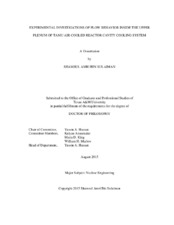| dc.contributor.advisor | Hassan, Yassin A | |
| dc.creator | Sulaiman, Shamsul | |
| dc.date.accessioned | 2019-12-16T22:38:20Z | |
| dc.date.available | 2019-12-16T22:38:20Z | |
| dc.date.created | 2015-08 | |
| dc.date.issued | 2015-06-17 | |
| dc.date.submitted | August 2015 | |
| dc.identifier.uri | https://hdl.handle.net/1969.1/187002 | |
| dc.description.abstract | One of the candidates for advanced reactor designs identified for the Next Generation Nuclear Plant (NGNP) is the Very High Temperature Reactor (VHTR). The Reactor Cavity Cooling System (RCCS) is a promising passive decay heat removal system for the VHTR to ensure reliability of the transfer of the core decay heat to the environment whilst ensuring that the temperature of structures and concrete wall are under threshold limits during normal and off-normal operations, including accident conditions.
The experimental test facility reflects a ⅛ scale model of one conceptual passive decay heat removal system for advanced nuclear reactor designs. This ⅛ scale air-cooled RCCS experimental test facility was scaled, designed, constructed, and operated to study pertinent multifaceted thermal hydraulic phenomena based on the General Atomics (GA) concept for the Modular High Temperature Gas Reactor (MHTGR) during steady state and transient conditions. The experimental facility represents a portion of a full-scale air-cooled RCCS with an upper/hot plenum, four coolant risers and air as a coolant. The experimental facility is highly instrumented for measurement and analysis of highly chaotic spatial and temporal behavior of turbulent flows. The overall verification for the safe operation was achieved during the experimental facility shakedown.
Groundwork for experimental investigations focusing on the complex nature of turbulence mixing flow behavior and characteristics inside the upper/hot plenum have been carried out successfully. The steady-state condition was achieved and the experimental test facility capabilities were confirmed to permit flexibility for various multi-parameter investigations for CFD-grade database verification. The experimental data of temperature and velocity flow fields during steady state and transient conditions showed the changes observed in the turbulent characteristics and mixing phenomena at the upper/hot plenum instigated by the parallel jets issued from the risers’ outlets by means of movable thermocouple racks and 2D Particle Image Velocimetry (PIV). Several flow instabilities that have significant impacts on the cooling performance of the air-cooled RCCS were identified. Analysis of the evolution of coherent structures within the flow field for selected cases was performed using the Proper Orthogonal Decomposition (POD) technique. | en |
| dc.format.mimetype | application/pdf | |
| dc.language.iso | en | |
| dc.subject | air-cooled reactor cavity cooling system (RCCS) | en |
| dc.subject | flow reversal | en |
| dc.subject | proper orthogonal decomposition (POD) | en |
| dc.title | Experimental Investigations of Flow Behavior Inside the Upper Plenum of TAMU Air-Cooled Reactor Cavity Cooling System | en |
| dc.type | Thesis | en |
| thesis.degree.department | Nuclear Engineering | en |
| thesis.degree.discipline | Nuclear Engineering | en |
| thesis.degree.grantor | Texas A&M University | en |
| thesis.degree.name | Doctor of Philosophy | en |
| thesis.degree.level | Doctoral | en |
| dc.contributor.committeeMember | Annamalai, Kalyan | |
| dc.contributor.committeeMember | King, Maria D | |
| dc.contributor.committeeMember | Marlow, William H | |
| dc.type.material | text | en |
| dc.date.updated | 2019-12-16T22:38:20Z | |
| local.etdauthor.orcid | 0000-0002-7238-3333 | |


